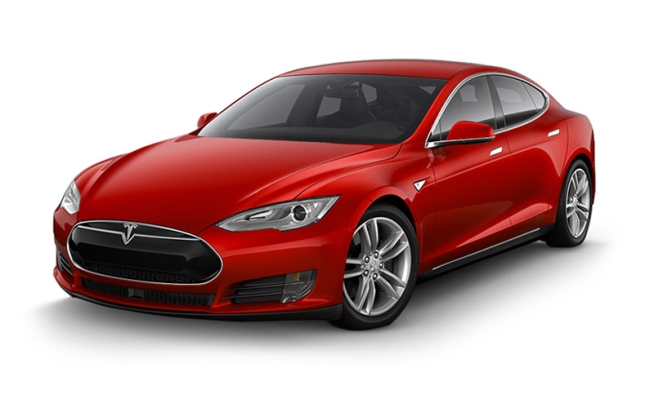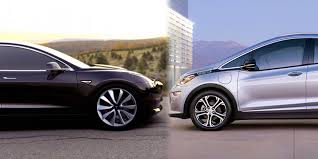This has to be the battle Chevy has been waiting for. So without further ado, lets compare and judge this EV prize fight.
Pricing
Tesla has stated from the beginning that the Model 3 would cost the consumer $35,000.00 before federal and state tax credits. They delivered on that promise at the recent unveiling. Chevy’s Bolt will cost $37,500 before federal and state tax credits. Let’s stop here for a second and make sure everyone understands what a tax credit is. The tax credit does not mean everyone will get it. It will depend on multiple factors when filling your taxes. So we need to measure these cars by the MSRP without calculating the tax credit. If you decide to lease either car, then you don’t get the tax credit at all. Now, I know there could be an argument between which car will have the most technology in the base price, but I have to say with Tesla’s track record on delivering technology in their cars, they will crush Chevy. The winner is Tesla!
Winner: Tesla Model 3
Range
Chevy’s website states that the Bolt’s range will be more than 200 miles per charge. Tesla is stating their Model 3 will have 215 miles per charge. Since Tesla is telling us that 215 miles per charge is just the beginning, one would think there will be options to get the car up to 300 miles per charge maybe even higher. The Internet rumors have been saying Chevy might hit the 240 miles per charge range, which would be very nice but the one thing most can all agree on is both cars will not hit their EPA stated numbers. There are just too many factors that can hinder range on electric vehicles. I have to give this round to Tesla as they have better battery technology to date.
Winner: Tesla Model 3
Technology
With three vehicles in the Tesla line-up, we know what to expect from Tesla in regards to their technology from AutoPilot to the big computer screen that runs the whole car (there are only 2 buttons/switches on the dash). With Chevy, we really just don’t have a lot to go on yet other than what’s on their website. So far, from everything I have read about the Bolt’s technology, it seems they have a lot crammed into their base car, but they are going up against Tesla who really is a technology company first. Technology goes to Tesla!
Winner: Telsa Model 3
Performance
This will be a quick one. Tesla is faster than the Bolt. Elon said it best “We do not build slow cars” Tesla wins!
Winner: Tesla Model 3
The Look
Now here is where we come to the fork in the road. I assume Chevy’s design engineers want to wow us with their design capabilities, but the powers to be at Chevy are traditionally old school guys who think a car should look a certain way. Really guys? Why don’t you listen to the consumer? We want edgy in-your- face cars. Cars that will wow people as they pass by. Cars with such a wow factor they fly off the lots. That’s the space where Tesla lives. More wow factor in every design. You go Tesla! We know who wins this one don’t we? All you have to do is look at both cars side by side.
Winner: Tesla Model 3
Delivery Schedule
I have to admit; Tesla has not been the most punctual car manufacture as it relates to keeping a delivery date. Chevy has many more people and money to throw at production issues to make sure they hit their delivery dates. I just hope that Tesla has really learned from their past mistakes and can prove everyone wrong. Crossing my fingers…… The winner of this category goes to Chevy.
Winner: Chevy Bolt
Charging
One word ‘Supercharger” Enough said. Tesla kills Chevy. Chevy has no charging infrastructure and they rely on others to build it. That’s going to work, right? I blogged recently on this topic. It was called “Range anxiety – The Electric Highway” Please read that blog.
Winner: Tesla Model 3
Well there you go. I really feel with all the information we have so far on both cars; Tesla wins hands down over Chevy. Tesla might be a young car company, but they are truly reshaping the automotive industry like it or not.
Update: Now that the Model 3 has been out for quite some time (3 years or so), there have been some used Model 3s coming on the market—and they’re a great way to get into a Tesla and save some money (you can learn more about that here).
If you’re in the market for a used Model 3, I recommend checking out the following resources:
- https://www.tesla.com/inventory/used/m3/
- https://www.findmyelectric.com/used-tesla-model-3/
- https://www.tesla.com/support/ordering-used-tesla/
@elonmusk @chevyboltnews @teslamotors @chevrolet @pjfranks1509


Fast DC charging capability is, as I understand it, an option on the Bolt. And Mary Barra recently stated flatly that GM would not be investing anything in building out a charging network. But that said, there is a pretty wide network of chargers available these days from Chargepoint and others, so the existence of the Supercharger network isn’t an all or nothing advantage to Tesla.
And while I believe that Model 3’s range will exceed the Bolt’s, it’s not completely fair to compare a car debuting in late 2016 to one in late 2017, as the latter has the benefit of an additional year of battery technology development. On the other hand, I’ve read that GM is paying $145/kWh (ramping down to $100 by 2022: http://insideevs.com/gm-chevrolet-bolt-for-2016-145kwh-cell-cost-volt-margin-improves-3500/), so if the Gigafactory can’t beat that price, then it was a very bad investment of $5B—meaning I believe that Tesla’s battery cost should be something less than $145/kWh, compared to the ~$200 they’re rumored to be paying today. The bigger the price gap between the two cars’ battery costs, the bigger the advantage to Tesla.
LikeLike
Actually, while DC charging capability exists, very few of the current DC charging stations have the CCS connector required by the Bolt (equipped with the optional DC charging port). Most existing stations are Chademo only used by Nissan and other early adopters. Most stations are 20 – 50 KW stations that would take many hours to recharge a Bolt to 200 miles. Tesla superchargers are rated up to 135 KW. The non-tesla DC charging stations are owned by a variety of networks which have several different ways of paying for the charge which is overly complicated, there are generally only 1 or 2 charge ports at each location vs 8-12 for supercharge locations. Lastly current non-Tesla EV drivers are well aware that often these non-tesla DC stations are ‘broken’ and unusable.
LikeLike
Have both a 500e and Spark EV on lease; the fast charge is FAST and will work nicely with the Bolt. There’s bunches of fast chargers around town already in San Diego and IMHO, that’s advantage CCS over supercharger stations in the long run — Tesla is now a member of the CCS council if that shows how Tesla is hedging their bet on where they’re going eventually with their network.
Our 3 year plan is Bolt + M3. Bolt’s hatchback wins for the Family four+golden retriever. Honestly, I believe these cars at the end of the day are going to be a lot more comparable than not for the majority of owners. The simple fact, most mainstream people for 30-40k cars will not fork over 2-3k for ludicrous option when the base dose 0-60 in 6sec.
LikeLike
Let me say it simple. If anybody tells me that I can charge my car at more then 5.000 places, it does not give me a good feeling. But when I look at the Supercharger map I’m instantly sure about my trip(s). The fact that GM doesn’t care about the charging needs of their customers can turn out to be a big mistake. If they saw the light they would contact Tesla and share the supercharger network, both in US and Europe. Then they could be, maybe, a bit succesfull. For now their chances are minimal. Besides that, where is their Autopilot? After driving 15.000 miles on Autopilot it is for me unthinkable to buy any car that doesn’t have this feature. Maybe now still a bit unknown by most people but as the moment comes close that GM will be able to deliver everybody knows what AP can do.
LikeLike
No question that the Bolt will be a fine choice around town, but you cannot change the law of physics. When traveling long distance, if it takes you 30 – 40 minutes to add 60 miles to a 500e or Spark EV, it will take 90 minutes to 2 hours to add 180 miles to a Bolt on a 50KW DC Charger. Imagine a trip between San Diego and Bakersfield. A Tesla or Bolt would need to stop once along the way. There may be 20 fast chargers along this route, but typically only 2 charge ports per station. Also only half those have CCS ports. Each Supercharger location along the way has 6-12 ports. The Tesla will charge in 1/3 the time and be less likely to need to wait in line than the Bolt. San Diego is currently one of the best cities for CCS availability, but is still quite rare everywhere else. Tesla rolls out supercharger locations much faster than all the other DCFC installers combined because it supports their car business. There is no such coordination among DCFC installers.
I am not suggesting that the Tesla way is the only way. It may be better if utilities or energy companies (such as Shell) routinely installed DC chargers at every ‘gas station’.
LikeLike